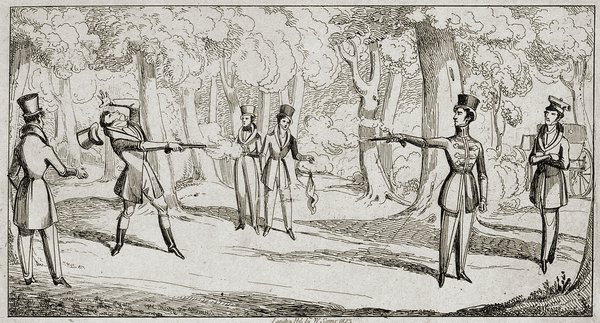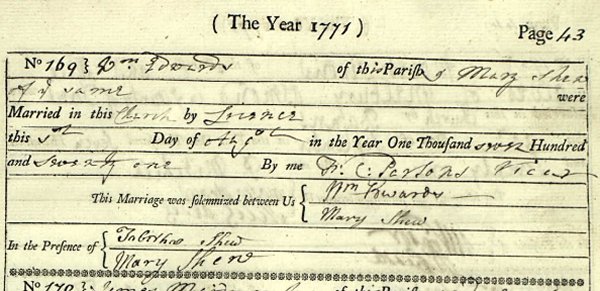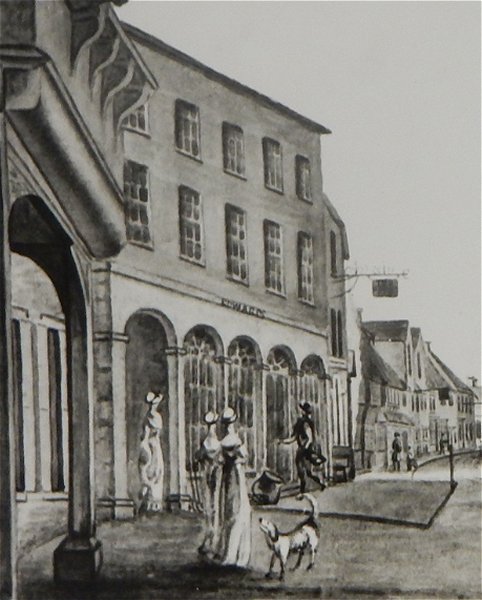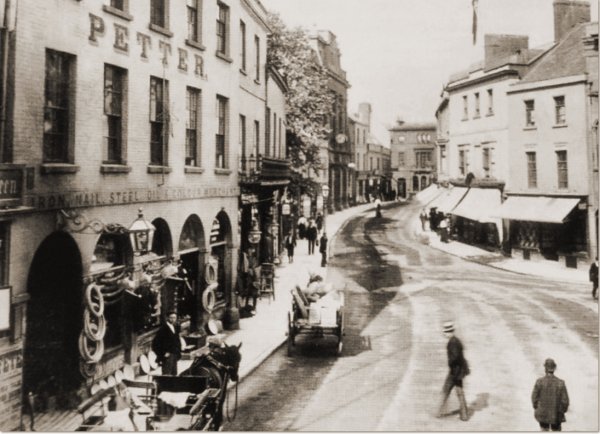Yeovil Trades & Traders
William Edwards
Ironmonger (and duellist) of the Borough
William Edwards was born in Yeovil in 1748 and baptised at St John's church on 24 November 1748. He was the son of Edward Edwards, possibly of Preston Plucknett. William's siblings were Betty (b1755), Mary (b1759), Jane (b1764), Sarah (b1765) and Edward (b1768).
Nothing is known of William's early life but, certainly by 1771, he was recorded as an ironmonger of Yeovil. On 3 August 1771, at St John's church, he married Mary Shaw (1748-1828). They were to have eight children (at least two died in infancy): Elizabeth (1772-1815), Mary (1774-1774), James (1776-1776), Mary (b1779), James (b1780), William (1782-1868), John (b1784) and George (b1785).
It appears that the newly-married 23-year-old William Edwards may also have been something of a hot-head as reported in the 21 December 1771 edition of the Oxford Journal and several other organs, as follows: "Last Week a Duel was fought at Yeovil between Mr J Peddle, a young surgeon, and Mr W Edwards, an Ironmonger of that town. It arose from some words the evening before, when they were near coming to blows; but Mr P not approving such a vulgar method of deciding the dispute, proposed meeting with pistols next morning. Mr E being a man of equal courage, readily assented to it. Accordingly they met, with their seconds and two surgeons: the seconds (being more prudent than the two antagonists) privately agreed to charge the pistols only with powder, but to keep up the farce, appeared to be very serious on the occasion , and sharply reproved one of them for swearing, telling him how imprudent it was, when probably, in five minutes, he might be in eternity. The same Form and Parade was observed, as would have been between two noble Lords. The pistols were charged by the seconds, the ground paced out, their breasts examined, and a signal for firing given, by the dropping of a Handkerchief. Accordingly they fired in the same Instant of time, when both were thoroughly persuaded of having just missed each other - Mr Peddle not thinking he had proper satisfaction, proposed swords; when the seconds interfering, and rallying them sufficiently for their folly, by telling them that the pistols had been charged only with powder, they shook hands, and parted good friends."

A lithograph of 1823 by W Sams, entitled "Duelling".
In 1782 and 1783, William was elected and served as Churchwarden together with Gabriel Baker - a mercer, draper, undertaker and Yeovil's postmaster.
William presumably had great success as an ironmonger, since in 1790 he built large new premises in the prime location of the Borough. The premises, the oldest in the Borough, survive today as the premises of Superdrug (see Gallery). This same year, he was listed as an ironmonger and cutler in the Universal British Directory.
In 1792 and 1793, William was recorded as the Yeovil agent for the Royal Universal Tontine (a tontine is an investment linked to a living person which provides an income for as long as that person is alive. Such schemes originated as plans for governments to raise capital in the 17th century and became relatively widespread in the 18th and 19th centuries).
William appears in the Churchwardens' Accounts for several years for supplying various ironmongery goods (itemised for 1793 below); in 1793 his annual bill amounted to £1 3s 10½d, in 1797 his bill was £6 1s 9d, in 1798 it was £5 19s 3d and in 1799 it was £13 10s 11½d (about £1,360 at today's value). In 1800 it was £2 4s 5d.
It appears that William's health may have been suffering as, even before his death at the age of 53 in September 1801, Mary took over the running of the business as witnessed by an entry from the Register of Duties Paid for Apprentices Indentures in which it is recorded that she, as an Ironmonger, took on John Buckland as an apprentice on 1 February 1801 (see Gallery).
After William's death in 1801, Mary took over the running of the ironmongery business and the Churchwardens' Accounts show annual payments to her (in her own name) as follows - in 1801 the annual bill was £1 15s 0¾d, in 1802 it was £1 15s 3½d, in 1803 the bill was chiefly for oil for the bells at £2 14s 9½d. In 1804 there was an annual bill for £1 1s 0d for cleaning the "Candlestick Desk etc" and a second bill of £1 4s 11d "for Oil for Bells White Lead and Sundries about the church".
There is no doubt that Mary ran the business after William's death, certainly to 1824, and possibly until the business was sold to Josiah Hannam in 1827, when he issued a circular announcing that he had moved his business to the Borough and taken over the ironmongery business "so long held by Mr Edwards".
Although in 1801 the Churchwardens' Accounts referred to Mrs Mary Edwards, thereafter the business was referred to as 'William Edwards, Ironmonger' - in 1803, 1807,1809, 1810,1812, 1813, 1815, 1816 and 1818. In 1824, Pigot's Directory listed 'William Edwards, Ironmonger and Manufacturer of the Borough'.
Mary died in Yeovil in 1828, aged 80.
William Edwards' Bills to the Churchwardens
I've included William Edwards' only itemised annual bill to the Churchwardens for 1793 (at this time the year ended at Lady Day in what we would now consider the following year, so the entry for 25 January is correct). I'm not sure what, for instance, a 4d nail was but it almost certainly wasn't a fourpenny nail, so I assume it was a gauge of some kind. The entire year's bill of £1 3s 10½d equates to about £143 at today's value. The 'Best Hair Broom' at 2s 4d equates to around £14 at today's value.
| 1793 | Wm Edwards' Bill | |
| 25 May | A Spade | 2s 8d |
| 1 June | 100 8d & 300 10d Glass Nails | 3s 2d |
| 3 June | 100 each 6d 8d & 12d Ditto | 2s 2d |
| a pair hinges & 1/200 4d Clasp | 6d | |
| 4 June | 100 4d Clasp & 3" Nails | 1s 5½d |
| 100 each 8 & 10 Clasp, 1 Doz Screws 5d | 1s 11d | |
| 18 June | A Hook for Copsing the Trees | 1s 6d |
| 16 July | 2" Nails & Spikes | 9d |
| 31 July | 500 4d Round Head Nails | 1s 8d |
| 10 August | A Brush | 1s 0d |
| 31 August | 1/200 each 3 & 6d Cleat | 4½d |
| 23 September | 100 10d Clasp 1/200 3d brads & 4d French | 1s 1½d |
| 13 November | 3d Roundhead Nails | 2s 6d |
| 16 November | A Best Hair Broom | 2s 4d |
| 23 November | 1" Nails & Spikes | 4½d |
| 25 January | 1/200 4d French & 1/400 10d Nails | 4½d |
| £1 3s 10½d |
gallery

The entry of the 3 August 1771 marriage of William Edwards and Mary Shaw recorded in St John's marriage register.

A painting made in 1810 of the Borough looking towards High Street which runs to the distance at left. The building at centre was the Market House, built in 1740, and behind it to the right was the Butchers' Shambles, built in 1803. The Tolle Hall is seen at right, surmounted by its clock or 'horolitch'. At left, the building with the arched ground floor is the only building surviving today in the Borough and originally the ironmongery shop of William Edwards - by the time of this painting, the business was being run by his widow, Mary.

An enlargement of the above painting. At centre, the building with the arched ground floor is the oldest building surviving in the Borough today. It was built by, and was originally the ironmongery shop of William Edwards, whose name appears on the front. Today it is Superdrug.

It appears that even before the death of William in September 1801, Mary took over the running of the business as witnessed by this entry from the Register of Duties Paid for Apprentices Indentures in which it is recorded that she, as an Ironmonger, took on John Buckland as an apprentice on 1 February 1801.

The record of William's burial on 8 September 1801 from St John's parish register.

The notice of William's death in the 24 September 1801 edition of the Bath Chronicle.

An advertisement for an apprentice was placed by Mary in the 14 November 1803 edition of the Salisbury & Winchester Journal.
![]()
In reply to the above advertisement, on 21 February 1804, Mary took on Lewis B Kingsbury as an apprentice - again, this entry is taken from the Register of Duties Paid for Apprentices.

Hannam & Gillett's ironmongery shop in the Borough - by the time of this photograph it was being run by James B Petter.

The oldest surviving building in the Borough and originally the ironmongery shop of William Edwards (in 1790), then Josiah Hannam followed by James Bazeley Petter and then Hill & Sawtell. Today it is Superdrug.
Will of William Edwards, 1801
I William Edwards of Yeovil in the County of Somerset Ironmonger revoking all former wills heretofore made by me I make this my last will and testament as follows From the good will & affection which I owe to my Wife Mary Edwards and relying & trusting to the justice which she will do to my Children I give unto my said Wife all my Real and Personal Estates whatsoever and wheresoever situated during her natural life as long as she continues my Widow but should my wife Marry after my decease then my will is that all my Property [word illegible] above be placed immediately into the hands of Wm Elnor and my daughter Elizabeth Edwards In Trust and the whole to be Sold immediately after such Marriage taking place and that my said Trusts do equally divide all my property equally share and share alike between my s[ai]d Wife and all my Children which may be living at the time of my decease should any of my Children at the time of my Death not attain the Age of twenty one years or be Married it is my request that no such dividend be made until [he?] becomes of Age or be Married And I do appoint my dearly beloved Wife my whole and sole Executrix of this my last Will and Testament made and declared this twenty third day of June one thousand eight hundred and one
Wm Edwards
Signed Sealed Published and Declared by the s[ai]d Testator Wm Edwards as and for his last Will and Testament in the presence of us who have subscribed our Names as Witnesses thereto in his presence and at his request and in the presence of each other
Mary Shaw
Thos Shorland
John Shaw
This Will
was
proved at London
the fourth day
of February in
the year of our
Lord one
thousand eight
hundred and two
before the Right
Honourable Sir
William Wynne
Knoght Doctor of
Laws Master
Keeper or
Commissary of
the Prerogative
Court of
Canterbury
lawfully
constituted by
the Oath of Mary
Edwards Widow
the Relict of
the deceased and
sole Executrix
named in the
said Will to
whom
Administration
was granted of
all and singular
the Goods
Chattels and
Credits of the
said deceased
having been
first sworn by
the Commission
duly to
Administer
Transcribed by Bob Osborn